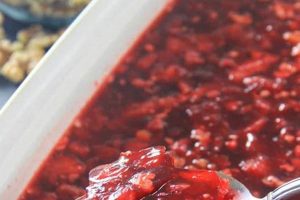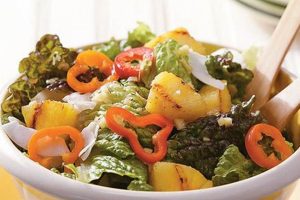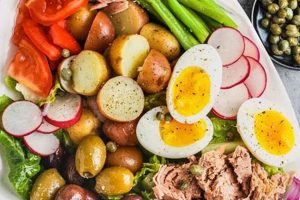A Mediterranean-inspired dish featuring farroan ancient grain with a nutty flavor and chewy texturecombined with classic Greek ingredients. Typical components include cucumbers, tomatoes, red onion, Kalamata olives, feta cheese, and fresh herbs like dill and mint. A lemon-herb vinaigrette or a simple olive oil dressing often completes the dish, providing a bright, tangy counterpoint to the other flavors. Variations can incorporate other ingredients like artichoke hearts, chickpeas, or bell peppers.
This culinary creation offers a nutritious and flavorful meal option. Farro provides a good source of fiber, protein, and various vitamins and minerals. The fresh vegetables contribute essential nutrients and antioxidants. The combination of ingredients creates a satisfying and well-balanced dish, suitable as a light lunch, a side dish, or a component of a larger meal. Its adaptable nature allows for customization based on seasonal ingredients and individual preferences, reflecting the long-standing Mediterranean culinary tradition of emphasizing fresh, local produce.
This exploration will delve further into specific ingredient selections, variations on the basic formula, tips for preparation and presentation, and nutritional information associated with this wholesome and delicious dish.
Tips for Preparing a Delicious Farro Salad
Achieving optimal flavor and texture requires attention to several key aspects of preparation.
Tip 1: Cook Farro Properly: Farro requires cooking similar to other grains. Rinse the farro before cooking. Use a ratio of approximately 2.5 parts liquid to 1 part farro. Simmering until tender but still slightly chewy, usually about 20-30 minutes, yields the best results. Overcooked farro can become mushy.
Tip 2: Toast the Farro (Optional): Toasting farro in a dry pan before cooking can enhance its nutty flavor profile.
Tip 3: Chill the Farro: Cooling the cooked farro completely before combining it with other ingredients prevents the salad from becoming soggy and helps maintain the distinct textures.
Tip 4: Use High-Quality Ingredients: Selecting fresh, ripe vegetables and flavorful feta cheese elevates the overall taste. Consider using locally sourced produce when available.
Tip 5: Balance the Vinaigrette: A well-balanced vinaigrette enhances the other flavors without overpowering them. The right balance of acidity, sweetness, and saltiness is crucial. Taste and adjust the vinaigrette as needed before adding it to the salad.
Tip 6: Don’t Overdress: Add the vinaigrette gradually, tossing gently to coat the ingredients evenly. Too much dressing can make the salad heavy and mask the individual flavors.
Tip 7: Add Herbs Generously: Fresh herbs provide brightness and depth of flavor. Dill, mint, parsley, and oregano complement the other ingredients well.
Tip 8: Serve at Room Temperature: Allow the salad to sit at room temperature for a short time before serving. This allows the flavors to meld and enhances the overall sensory experience.
Following these tips ensures a successful and flavorful farro salad experience, highlighting the nutritional benefits and culinary versatility of this ancient grain combined with the vibrancy of Mediterranean flavors.
The following section will offer variations and customizations for this dish, allowing for adaptation to individual preferences and dietary needs.
1. Farro Preparation
Farro preparation is fundamental to a successful Greek farro salad recipe. The grain’s texture and how it absorbs the vinaigrette directly impact the final dish. Incorrectly cooked farro can result in a mushy salad or, conversely, a toothsome, unpleasant texture. Properly prepared farro offers a chewy, nutty base that complements the fresh ingredients and enhances the overall culinary experience. For instance, using pearled farro, which cooks faster, might lead to overcooking if not carefully monitored, whereas semi-pearled farro requires a longer cooking time but retains a firmer texture. Choosing the right type of farro and cooking it correctly is crucial.
The cooking method also influences the final outcome. Rinsing farro before cooking removes excess starch, preventing stickiness. The liquid-to-grain ratio determines the farro’s tenderness. Too little liquid results in undercooked farro; too much creates a porridge-like consistency. Simmering farro gently, rather than boiling vigorously, promotes even cooking and prevents the grains from bursting. Cooling the cooked farro completely before combining it with other ingredients prevents the salad from becoming soggy and maintains the individual textures of the components. These factors demonstrate the significance of meticulous farro preparation in creating a well-balanced and enjoyable salad.
In conclusion, farro preparation is not merely a preliminary step but an integral component of a successful Greek farro salad. Attention to detail throughout the cooking process ensures the farro achieves the desired texture and flavor, maximizing its ability to absorb the vinaigrette and complement the other salad ingredients. Understanding and implementing appropriate techniques elevates this seemingly simple step into a critical factor contributing to the overall quality and enjoyment of the dish.
2. Fresh Ingredients
Fresh ingredients are essential to a high-quality Greek farro salad. The vibrancy and overall flavor profile depend heavily on the quality and freshness of the components. Fresh produce offers crisp textures and bright, nuanced flavors that contribute significantly to the salad’s appeal. Consider the difference between a ripe, juicy tomato bursting with flavor and a bland, mealy tomato. This distinction directly impacts the overall sensory experience. Similarly, using fresh herbs like dill and mint provides a brightness and aromatic complexity that dried herbs cannot replicate. The delicate flavors of fresh herbs are essential for achieving an authentic and vibrant Greek farro salad. Wilted or less-than-fresh ingredients can detract from the overall quality, resulting in a less satisfying dish. The emphasis on fresh ingredients aligns with the broader Mediterranean culinary tradition, which prioritizes the use of seasonal, locally sourced produce.
The interplay between fresh ingredients and the other components of the salad is also crucial. Fresh vegetables, like cucumbers and red onion, provide a refreshing counterpoint to the nutty farro and salty feta. The brightness of fresh lemon juice enhances the flavors of the other ingredients without overpowering them. Using high-quality olive oil contributes a subtle fruitiness and richness that complements the other flavors. The freshness of these ingredients allows their individual characteristics to shine through, creating a harmonious and well-balanced flavor profile. For example, using in-season tomatoes at their peak ripeness maximizes their sweetness and juiciness, contributing significantly to the salad’s overall flavor. Conversely, using out-of-season or less-than-fresh tomatoes can result in a bland or even unpleasant taste.
In summary, the emphasis on fresh, high-quality ingredients is paramount in crafting a truly exceptional Greek farro salad. Prioritizing freshness not only enhances the flavor and textural complexity but also aligns with the core principles of Mediterranean cuisine. The careful selection and proper handling of fresh produce contribute significantly to the overall culinary experience, transforming a simple salad into a vibrant and satisfying dish. Understanding this connection allows for informed ingredient choices and ultimately leads to a more enjoyable and flavorful result.
3. Authentic Greek Flavors
Authentic Greek flavors are central to a successful Greek farro salad recipe. The distinct taste profile of this salad relies on specific ingredients and their harmonious interplay. Understanding these elements is crucial for replicating the characteristic brightness, saltiness, and herbal notes that define this dish. The careful selection and balance of these flavors distinguish a truly authentic Greek farro salad from a generic Mediterranean-inspired salad. This exploration delves into the key components that contribute to this authentic taste experience.
- High-Quality Olive Oil:
Greek cuisine emphasizes the use of high-quality extra virgin olive oil. Its fruity and peppery notes provide a foundational flavor element in the salad dressing and contribute to the overall richness of the dish. Selecting a robust olive oil enhances the other flavors without overpowering them. The quality of the olive oil significantly impacts the final taste, so choosing a good one is essential.
- Salty, Briny Olives and Feta:
Kalamata olives and feta cheese provide the characteristic salty, briny element crucial to Greek cuisine. Kalamata olives offer a rich, complex flavor, while feta contributes a tangy, creamy saltiness. The combination of these two ingredients creates a savory depth that balances the brightness of the other components. Their unique flavor profiles are difficult to substitute without compromising the authenticity of the salad.
- Fresh Herbs and Lemon:
Fresh herbs, particularly dill, mint, and oregano, contribute a bright, herbaceous aroma and flavor that are essential to Greek cuisine. Lemon juice adds a refreshing acidity that cuts through the richness of the olive oil and feta. The combination of these elements creates a vibrant, layered flavor profile. Using dried herbs instead of fresh ones significantly alters the taste and compromises the authenticity of the salad. The zesty brightness of lemon complements the other ingredients perfectly.
- Balance and Harmony:
Authentic Greek flavors rely not only on specific ingredients but also on their balance and harmony. No single element should overpower the others. The goal is to create a cohesive flavor profile where each ingredient complements and enhances the others. Achieving this balance requires careful consideration of proportions and a nuanced understanding of how different flavors interact. For example, too much lemon juice can make the salad overly tart, while too little diminishes its brightness. Finding the right balance is crucial.
These distinct elements combine to create the complex and satisfying flavor profile that defines an authentic Greek farro salad. Understanding the role and importance of each component allows for informed ingredient selection and preparation, ensuring a truly authentic and delicious culinary experience. Successfully incorporating these elements not only replicates the flavors of Greece but also showcases the importance of fresh, high-quality ingredients in creating a memorable dish.
4. Balanced Vinaigrette
A balanced vinaigrette is crucial to a successful Greek farro salad. The vinaigrette acts as a unifying element, binding the individual ingredients and creating a cohesive flavor profile. It provides the necessary acidity to cut through the richness of the farro and feta, while also complementing the fresh vegetables and herbs. An unbalanced vinaigrette can negatively impact the overall dish. A dressing that is too acidic can overwhelm the other flavors, while a dressing that lacks acidity can result in a bland, uninspired salad. A properly balanced vinaigrette enhances, rather than masks, the individual flavors of the ingredients. Consider a vinaigrette made with overly strong red wine vinegar; it would dominate the delicate flavors of fresh dill and mint. Conversely, a vinaigrette made with insufficient lemon juice would fail to provide the necessary brightness to balance the nutty farro and salty feta. The balance of acidity, sweetness, and saltiness in the vinaigrette is therefore essential for achieving a harmonious flavor profile.
Achieving this balance requires careful consideration of the vinaigrette’s components. Traditional Greek vinaigrettes often employ high-quality extra virgin olive oil, fresh lemon juice, dried oregano, salt, and pepper. The ratio of oil to acid is critical. Too much oil creates a heavy, greasy dressing, while too much acid results in an overly tart flavor. The addition of a touch of sweetness, such as a drizzle of honey or a pinch of sugar, can further enhance the balance and complexity of the vinaigrette. Emulsification, achieved by whisking the ingredients together vigorously, creates a stable and evenly distributed dressing that coats the salad ingredients effectively. This emulsification prevents the oil and vinegar from separating, ensuring a consistent flavor in every bite. Furthermore, the quality of the ingredients used in the vinaigrette directly impacts its overall flavor profile. Using fresh lemon juice, as opposed to bottled lemon juice, contributes a brighter, more nuanced acidity. High-quality extra virgin olive oil provides a superior flavor and texture compared to lower-grade oils.
In conclusion, a balanced vinaigrette is not merely a dressing but an integral component of a well-executed Greek farro salad. It serves as a bridge, connecting the individual flavors and creating a unified, harmonious dish. The careful selection and balance of ingredients in the vinaigrette are crucial for achieving the desired flavor profile. Attention to detail in its preparation elevates the salad from a simple collection of ingredients to a complex and satisfying culinary experience. Understanding the significance of a balanced vinaigrette allows for a more informed approach to its creation and contributes significantly to the overall success of the Greek farro salad.
5. Herbs and Spices
The strategic use of herbs and spices significantly contributes to the authentic flavor profile of a Greek farro salad. These aromatic components provide depth and complexity, transforming a simple grain salad into a vibrant culinary experience. Fresh herbs, in particular, play a crucial role. Dill, with its slightly tangy, anise-like flavor, adds a refreshing brightness. Mint contributes a cool, herbaceous note that balances the richness of the other ingredients. Oregano, a staple in Greek cuisine, provides a subtle earthy, slightly bitter counterpoint. The interplay of these herbs creates a nuanced aromatic profile that defines the salad’s character. Consider a salad made without fresh herbsit would lack the distinctive vibrancy and freshness that define the dish. Substituting dried herbs alters the flavor profile, resulting in a less authentic and less nuanced taste. The freshness of the herbs is paramount; their volatile oils, released when chopped or torn, contribute significantly to the overall sensory experience.
Beyond fresh herbs, certain spices also play a supporting role. Dried oregano, while sometimes used fresh, is more commonly employed in its dried form in this context. It offers a more concentrated flavor that complements the other ingredients without overpowering them. A pinch of dried thyme can add a subtle earthy note, further enhancing the complexity of the flavor profile. However, restraint is key with dried spices; their potency requires judicious use to prevent them from dominating the delicate flavors of the fresh herbs and vegetables. For instance, adding too much dried oregano can create a bitter, medicinal taste that detracts from the overall balance of the salad. The choice and quantity of spices should complement, not compete with, the fresh herbs and other ingredients. This careful balance is essential for achieving an authentic and harmonious flavor profile.
In conclusion, the selection and application of herbs and spices are integral to crafting a successful Greek farro salad. Fresh herbs like dill, mint, and oregano provide the signature brightness and herbaceous notes that define the dish. Judicious use of dried spices like oregano and thyme can further enhance the complexity of the flavor profile. Understanding the role and interplay of these aromatic components allows for informed choices, ensuring a truly authentic and flavorful culinary experience. The careful balance of these elements distinguishes a well-crafted Greek farro salad from a generic grain salad, demonstrating the transformative power of herbs and spices in culinary creations.
6. Proper Assembly
Proper assembly is a critical factor in maximizing the flavor and textural enjoyment of a Greek farro salad. The way ingredients are combined and layered influences the distribution of flavors and the overall sensory experience. This involves more than simply tossing ingredients together; it requires a thoughtful approach that considers the characteristics of each component and how they interact with one another. Proper assembly ensures that every bite delivers a balanced and harmonious combination of flavors and textures, elevating the salad from a simple mix of ingredients to a well-composed dish.
- Ingredient Order:
The order in which ingredients are combined can significantly affect the final outcome. Sturdier ingredients, like the cooked farro, form the base, while more delicate components, such as fresh herbs, are added last to prevent bruising or wilting. This layering approach helps maintain the integrity of each ingredient and ensures even distribution of flavors. For instance, adding the vinaigrette before delicate herbs would likely cause them to wilt and lose their vibrancy.
- Even Distribution of Vinaigrette:
Proper assembly ensures even distribution of the vinaigrette throughout the salad. This prevents certain areas from becoming overly saturated while others remain dry. Gradually adding the vinaigrette and tossing gently ensures that all ingredients are lightly and evenly coated, maximizing flavor distribution and preventing a soggy salad. Simply pouring the vinaigrette over the top can result in uneven flavor and texture.
- Visual Appeal:
Proper assembly also considers the visual appeal of the salad. Distributing colorful ingredients evenly throughout creates an aesthetically pleasing presentation that enhances the dining experience. Consider the visual contrast between the deep green of Kalamata olives, the bright red of tomatoes, and the creamy white of feta cheese. Strategic placement of these elements elevates the visual appeal and makes the salad more enticing.
- Textural Contrast:
Proper assembly maintains the textural contrast between the various ingredients. The chewy farro, crisp vegetables, and creamy feta offer a variety of textures that contribute to a more satisfying sensory experience. Combining ingredients in a way that preserves these textural differences is crucial. For example, overmixing could damage delicate ingredients and compromise the desired textural variety.
In conclusion, proper assembly is an essential step in creating a truly exceptional Greek farro salad. It ensures optimal flavor distribution, maintains textural contrast, and enhances visual appeal. This attention to detail elevates the salad from a simple mixture of ingredients to a carefully composed dish, demonstrating the significant impact of proper assembly on the overall culinary experience. By considering the characteristics of each ingredient and how they interact with one another, proper assembly maximizes the enjoyment of this vibrant and flavorful salad.
7. Serving Suggestions
Serving suggestions enhance the enjoyment of Greek farro salad by offering complementary pairings and presentation options that elevate the overall dining experience. Consideration of these suggestions ensures the salad is served in a manner that maximizes its flavor profile and visual appeal, transforming a simple dish into a more complete and satisfying meal.
- Standalone Light Meal:
Greek farro salad can serve as a satisfying light meal, particularly during warmer months. Its combination of complex carbohydrates, protein, and healthy fats provides a balanced and nutritious option. The salad’s vibrant flavors and refreshing textures make it a particularly appealing choice for a light lunch or a simple dinner.
- Side Dish:
This salad complements a variety of main courses, acting as a refreshing counterpoint to richer dishes. Its Mediterranean flavors pair well with grilled meats, fish, or poultry. The salad’s light and herbaceous character provides a welcome contrast to heavier entrees, creating a balanced and flavorful meal.
- Part of a Larger Spread:
Greek farro salad contributes a healthy and flavorful element to a buffet or mezze platter. Its versatility allows it to seamlessly integrate into a larger spread of dishes, offering a refreshing and nutritious option alongside other culinary creations. The salad’s vibrant colors and textures enhance the visual appeal of a diverse table setting.
- Protein Enhancements:
Adding grilled chicken, fish, or chickpeas elevates the salad into a more substantial meal. These protein additions complement the existing flavors and provide additional nutritional value. Grilled halloumi cheese, with its salty, slightly squeaky texture, also provides a delicious and authentically Greek enhancement. These additions cater to varying dietary preferences and enhance the salad’s overall versatility.
These serving suggestions demonstrate the adaptability of Greek farro salad and its suitability for a variety of occasions and culinary contexts. Whether enjoyed as a standalone meal, a side dish, or part of a larger spread, thoughtful presentation and complementary pairings enhance the overall dining experience and showcase the versatility and deliciousness of this Mediterranean-inspired dish.
Frequently Asked Questions
This section addresses common inquiries regarding the preparation and enjoyment of this dish, offering practical guidance and clarifying potential uncertainties.
Question 1: What type of farro is best for this salad?
Pearled farro, with its shorter cooking time and slightly softer texture, is often preferred. Semi-pearled farro offers a chewier texture but requires a longer cooking time. Whole farro, while the most nutritious, requires the longest cooking time and may be too firm for some palates.
Question 2: Can quinoa or other grains be substituted for farro?
While other grains can be substituted, they will alter the salad’s characteristic nutty flavor and chewy texture. Quinoa offers a lighter, fluffier texture, while barley provides a similar chewiness but a different flavor profile.
Question 3: How long can the salad be stored?
Properly stored in an airtight container in the refrigerator, the salad can last for up to three days. The texture of the farro may soften slightly over time.
Question 4: Can the salad be made ahead of time?
The salad can be prepared a day in advance, excluding the vinaigrette. Adding the vinaigrette just before serving helps maintain the crispness of the vegetables.
Question 5: What are some suitable protein additions?
Grilled chicken, fish, chickpeas, or halloumi cheese complement the salad well, adding protein and enhancing its versatility as a main course.
Question 6: Can the vinaigrette be adjusted to personal preference?
The vinaigrette can be customized by adjusting the ratio of oil to acid, adding a touch of sweetness, or incorporating other herbs and spices.
Addressing these common queries provides a deeper understanding of the recipe’s nuances, empowering individuals to create and enjoy a successful and flavorful culinary experience. Clarifying these points often leads to greater confidence in the kitchen and encourages culinary exploration.
The following section will provide a complete recipe for creating this dish, incorporating the insights and guidance offered throughout this exploration.
Greek Farro Salad Recipe
This exploration has provided a comprehensive overview of a Greek farro salad recipe, encompassing key aspects from ingredient selection and preparation techniques to serving suggestions and variations. The importance of fresh, high-quality ingredients, including properly cooked farro, ripe vegetables, and authentic Greek elements like feta cheese and Kalamata olives, has been emphasized. The critical role of a balanced vinaigrette in unifying the flavors and the nuanced contribution of herbs and spices have also been thoroughly examined. Proper assembly techniques, considering both flavor distribution and visual appeal, have been detailed. Finally, various serving suggestions, highlighting the salad’s adaptability as a light meal, a side dish, or a component of a larger spread, have been offered.
This dish represents a confluence of nutritional value and culinary delight. Its adaptability allows for customization based on individual preferences and dietary needs, while its inherent flavor profile offers a satisfying and refreshing experience. Further exploration of Mediterranean cuisine and its emphasis on fresh, wholesome ingredients is encouraged, offering a pathway to both culinary enrichment and a deeper appreciation for the interconnectedness of food, culture, and well-being. The provided insights empower culinary enthusiasts to confidently recreate this dish and embark on further culinary explorations, fostering an appreciation for the art of combining simple ingredients to create flavorful and nourishing meals.






